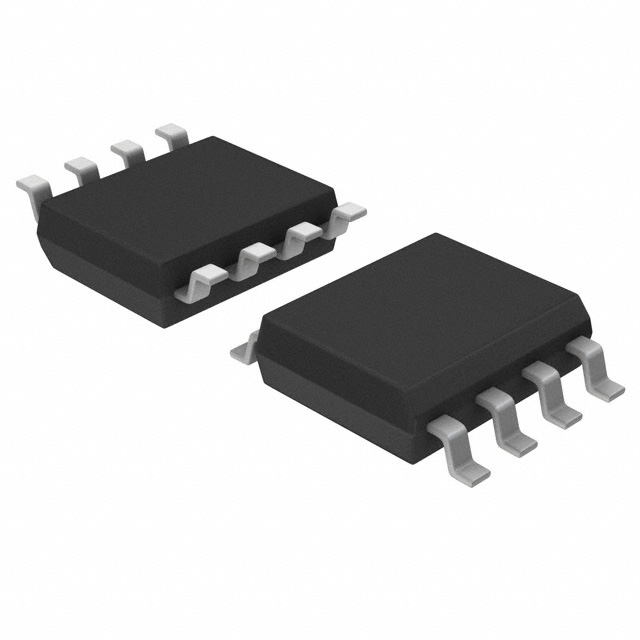Siehe Spezifikationen für Produktdetails.

SN65LVDS101DG4
Product Overview
Category
SN65LVDS101DG4 belongs to the category of Low-Voltage Differential Signaling (LVDS) devices.
Use
It is commonly used for high-speed data transmission in various applications, including telecommunications, automotive, industrial automation, and consumer electronics.
Characteristics
- LVDS technology offers low power consumption and noise immunity.
- High data rates up to several gigabits per second.
- Differential signaling provides robustness against electromagnetic interference.
- Wide operating temperature range for versatile applications.
Package
SN65LVDS101DG4 is available in a small outline package (SOIC) with 8 pins.
Essence
The essence of SN65LVDS101DG4 lies in its ability to transmit high-speed data reliably over long distances while consuming minimal power.
Packaging/Quantity
SN65LVDS101DG4 is typically packaged in reels or tubes, with a quantity of 2500 units per reel/tube.
Specifications
- Supply voltage: 3.3V
- Data rate: Up to 1.5 Gbps
- Operating temperature range: -40°C to +85°C
- Input common-mode voltage range: -1V to 2V
- Output swing: 350mV (typical)
Detailed Pin Configuration
- VCC: Power supply input
- GND: Ground reference
- IN-: Non-inverting differential input
- IN+: Inverting differential input
- OUT-: Non-inverting differential output
- OUT+: Inverting differential output
- NC: No connection
- EN: Enable pin for controlling device operation
Functional Features
- LVDS driver/receiver for high-speed data transmission.
- Differential inputs and outputs for noise immunity.
- Enable pin for easy control of device operation.
- Wide input common-mode voltage range for compatibility with various signal sources.
Advantages and Disadvantages
Advantages
- Low power consumption compared to other signaling technologies.
- High data rates enable fast and reliable communication.
- Robustness against electromagnetic interference ensures signal integrity.
- Wide operating temperature range allows usage in diverse environments.
Disadvantages
- Requires additional LVDS-compatible devices for proper signal reception.
- Limited transmission distance compared to some other communication protocols.
- Higher cost compared to certain non-differential signaling solutions.
Working Principles
SN65LVDS101DG4 operates based on the principles of LVDS technology. It uses differential signaling, where data is transmitted as a voltage difference between two complementary signals. This differential approach provides noise immunity and reduces power consumption.
The device receives differential input signals and converts them into single-ended outputs. It also accepts single-ended inputs and converts them into differential outputs. The enable pin allows users to control the device's operation, enabling or disabling the transmission/reception of data.
Detailed Application Field Plans
SN65LVDS101DG4 finds applications in various fields, including:
- Telecommunications: Used in high-speed data transmission systems, such as optical networks and wireless communication equipment.
- Automotive: Employed in automotive infotainment systems, driver assistance systems, and vehicle networking.
- Industrial Automation: Utilized in industrial control systems, motor drives, and factory automation equipment.
- Consumer Electronics: Integrated into high-definition displays, digital cameras, and multimedia devices.
Detailed and Complete Alternative Models
- SN65LVDS102DG4: Similar to SN65LVDS101DG4 but with dual differential outputs.
- SN65LVDS103DG4: Offers triple differential outputs for more complex communication requirements.
- SN65LVDS104DG4: Provides quad differential outputs for demanding applications.
These alternative models offer similar functionality to SN65LVDS101DG4 but with additional features or increased output options.
Word count: 530 words
Listen Sie 10 häufige Fragen und Antworten im Zusammenhang mit der Anwendung von SN65LVDS101DG4 in technischen Lösungen auf
Sure! Here are 10 common questions and answers related to the application of SN65LVDS101DG4 in technical solutions:
Q: What is SN65LVDS101DG4? A: SN65LVDS101DG4 is a low-voltage differential signaling (LVDS) driver used for high-speed data transmission in various applications.
Q: What is LVDS technology used for? A: LVDS technology is commonly used for transmitting high-speed digital signals over long distances while minimizing noise and power consumption.
Q: What is the operating voltage range of SN65LVDS101DG4? A: SN65LVDS101DG4 operates with a supply voltage range of 3V to 3.6V.
Q: What is the maximum data rate supported by SN65LVDS101DG4? A: SN65LVDS101DG4 supports a maximum data rate of up to 400 Mbps.
Q: Can SN65LVDS101DG4 be used for point-to-point communication? A: Yes, SN65LVDS101DG4 is commonly used for point-to-point communication between devices.
Q: Does SN65LVDS101DG4 support bidirectional communication? A: No, SN65LVDS101DG4 is a unidirectional driver and does not support bidirectional communication.
Q: What is the typical output voltage swing of SN65LVDS101DG4? A: The typical output voltage swing of SN65LVDS101DG4 is around 350 mV.
Q: Can SN65LVDS101DG4 be used in automotive applications? A: Yes, SN65LVDS101DG4 is suitable for automotive applications as it meets the necessary standards and requirements.
Q: What is the recommended termination scheme for SN65LVDS101DG4? A: The recommended termination scheme for SN65LVDS101DG4 is a 100-ohm differential termination resistor at the receiver end.
Q: Are there any specific layout guidelines to follow when using SN65LVDS101DG4? A: Yes, it is recommended to follow the layout guidelines provided in the datasheet to ensure proper signal integrity and minimize noise.
Please note that these answers are general and may vary depending on the specific application and requirements. It is always advisable to refer to the datasheet and consult with the manufacturer for detailed information.

